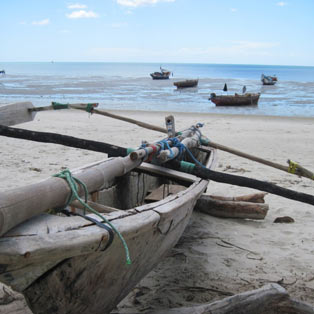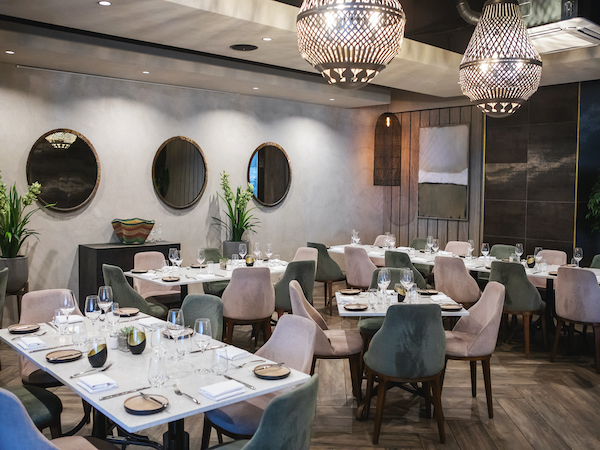News
Bagamoyo: ‘lay down your heart’
Friday, May 13th, 2011
The fishermen are back from sea. The mid-morning air over Bagamoyo’s old slave market is thick with smoke and smells from cooking-fires. Young men, work done till dusk, joke and laugh over a game of pool. Their voices mix with the music from the speakers, pots clanking, fish-frying and women’s easy banter. My nose is leading the way and my eyes wander from plate to pan picking out what’s being cooked up.
“Umzungu, umzungu – ” (Swahili for white person)
Looking around I see a herd of cows being chased in my direction and arms are waving me out of the way. The cows are heading towards the German storehouse, or what’s left of it: a few stone pillars, a solid foundation and the crumbling walls of the 19th Century German Custom House. The cobbled jetty that leads from the storehouse to the beach is where the cows will be loaded onto dhows to be shipped to Zanzibar.
It used to be slaves. People from Bagamoyo will tell you that the name of the town comes from the slaves, who on leaving Africa would say that you must “lay down your heart.” In other words leave your heart in Bagamoyo it will make the journey easier.
 I am on my way to STC or the “new” restaurant as it is more familiarly known to locals, not that there appear to be many other choices. It is in stone town where the cobbled streets are lined with houses that were built by wealthy Omani or Indian traders who ran the caravans transporting ivory and slaves from the interior. Now the residents have no money to up-keep these historic homes. There are some signs of rejuvenation in Bagamayo. It is happening pole-pole (slowly-slowly) as they say in Swahili.
I am on my way to STC or the “new” restaurant as it is more familiarly known to locals, not that there appear to be many other choices. It is in stone town where the cobbled streets are lined with houses that were built by wealthy Omani or Indian traders who ran the caravans transporting ivory and slaves from the interior. Now the residents have no money to up-keep these historic homes. There are some signs of rejuvenation in Bagamayo. It is happening pole-pole (slowly-slowly) as they say in Swahili.
The restaurant is in one of these refurbished residences. The main alteration to the building has been the replacement of the ceiling with a lighter wood. The decoration is simple. Thick fishing rope hangs in even loops from the tall ceiling. The solid walls are white-washed and wooden tables are covered with woven place mats. It doesn’t need anything more than that. The dark, wooden Zanzibar doors hand-carved with symbols reflecting the original owner’s wealth and status are the decorative focal point. The doors are always open and cowrie shells strung as curtains filter out the bright daylight and the everyday chatter of the town’s folk passing by. At night red light from ceiling bulbs floods the room to give the restaurant an “other –worldly” feel that seems to exaggerate the sense one has of Bagamoyo being dreamily caught between its rich past and its present realm as a quiet backwater fishing village.
The food here is really tasty (and well priced). The chapatti with vegetables is excellent. I should know; I’ve eaten it for three days in a row now. As it turns out chef, Mustafah Yakuti, is from Zanzibar, the “island of spices,” which I think explains somewhat why the food is such a pleasure to eat here. When I compliment him, Mustafa’s immediate response is, “when you have some time you must come and I will show you how to prepare it, you can take some notes and then you have something from Bagamoyo to take home with you.”
 It is such a warm and generous offer that for a minute I try to calculate how I can change my travel plans, but then realise that won’t be possible. Instead we talk about the food. We take satisfaction in mulling over the list of ingredients.
It is such a warm and generous offer that for a minute I try to calculate how I can change my travel plans, but then realise that won’t be possible. Instead we talk about the food. We take satisfaction in mulling over the list of ingredients.
To make the chapatti: flour, salt, warm water (not hot) and cooking oil instructs Mustafa. Rolling a chapatti sounds like an art form. He uses his hands to demonstrate. Actions fill the gaps between words missing in the translation from Swahili to English. “The chapatti must be rolled like a snake, it must be curled up from the middle,” he shows me making circles in the air. Then, hands in fists flexing back and forth, he says, “then you use the rolling pin.” As if sensing my next question he continues, “You should only apply oil on one side, on top. The pan must be dry if you want to avoid burning the chapatti.” Golden-brown chapattis, I sigh – how easy it sounds.
I want to know about the sauce that is served on the side. “It is a Concaise sauce: tomatoes, green pepper, onion and carrot are fried in oil and then blended together. Add a little Oregano,” Mustafa replies. “Do you get Oregano here?” I’m a bit surprised I haven’t seen any in the market. “Yes, but it’s expensive, we use black pepper, it is good too – a universal spice, found everywhere.”
They serve Ethiopian coffee here. However, it is the spiced tea you that you must order. A subtle blend of spices, a hint of cinnamon and something special that I cannot quite decipher with my taste buds. It is a gentle light pink fusion that makes me think of rose-petals. Mustafah explains, “there are no tea leaves, you just boil fresh spices like cinnamon, cardamom, and so on in a pot of water, then you let it stand for a week or two for the flavours to ferment before drinking.”
So that’s the secret– time. It is like a gift from Bagamoyo. Something to remember in my busy, modern life that to create something special takes time. Time to brew.
By Nicole McCreedy








